LG G4 is a strong contender for being the best television of 2024. With the combination of OLED black and MLA technology, we obtain an incredibly dynamic and vivid image, which will certainly captivate us completely. LG G4 is also proof that televisions equipped with an OLED panel supported by MLA technology are indeed suitable for viewing in a sunny room. The operating system, while not as open as the competition, offers many possibilities. Its greatest advantage is the well-known remote control with a pointer, which makes controlling the unit (in our opinion) one of the most convenient on the market. The factory colour reproduction, although not at a high level, after the calibration process, can be referred to as a reference screen, delivering a truly cinematic image. It is no coincidence that post-production studios choose televisions from this manufacturer. They alone offer such deep intervention possibilities in the image, thanks to 3D LUT calibration. It seems that the biggest (and perhaps only) disadvantage of this television is tonal transitions, which, although far from ideal, cannot be said to take away the pleasure of viewing. The remedy is provided by the manufacturer itself, and enabling the "Smooth Gradation" function will eliminate the vast majority of the stuttering. LG G4 also performs very well when watching various sports or other dynamic scenes. The motion smoother is extremely advanced and allows for tailoring the smoothing to one's needs. Thanks to HDMI 2.1 ports with their full functionality and the manufacturer's attention to detail, the tested television will find its place in the homes of many avid gamers. Every essential feature works flawlessly, and the low input lag in every mode is very pleasing. In summary, LG G4 is an extremely versatile television, allowing for entertainment in excellent quality both at night and during the day.
- Matching (Score)
- Our verdict
- TV appearance
- Where to buy
- Contrast and black detail
- HDR effect quality
- Factory color reproduction
- Color reproduction after calibration
- Smoothness of tonal transitions
- Image scaling and smoothness of tonal transitions
- Blur and motion smoothness
- Console compatibility and gaming features
- Input lag
- Compatibility with PC
- Viewing angles
- TV efficiency during daytime
- Details about the matrix
- TV features
- Apps
- Playing files from USB
- Sound
LG OLED G4 vs Samsung S85F OLED
Direct compare
G45 / G42
S85F / FAE / FAU
Available screen sizes: 55”

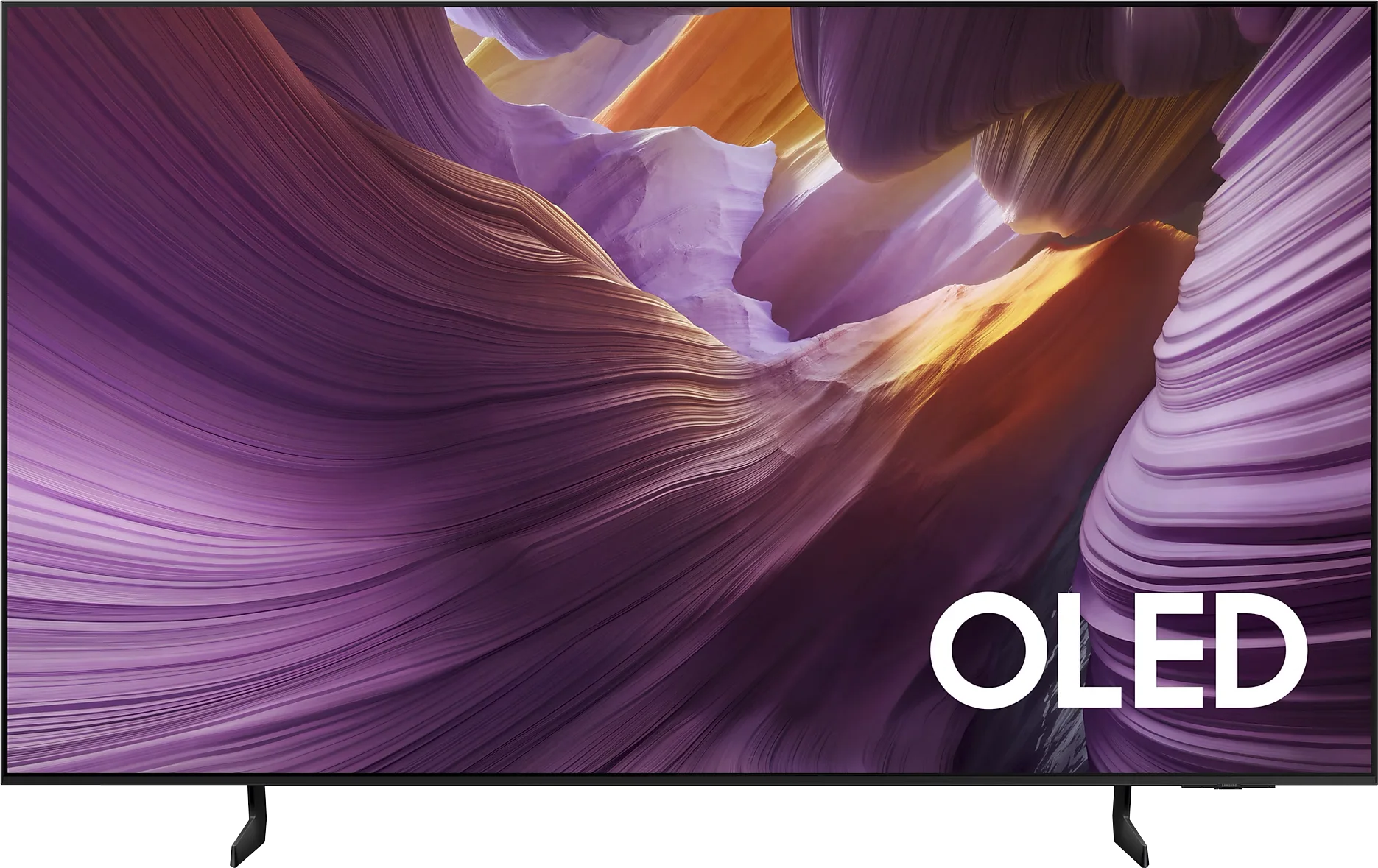
Panel type: WRGB OLED
Resolution: 3840x2160
System: WebOS
Model year: 2024
Complete the survey to find out the result

Panel type: QD-OLED
Resolution: 3840x2160
System: Tizen
Model year: 2025
Complete the survey to find out the result

Overall rating
8.6
8.0
Movies and series in UHD quality
8.5
8.3
Classic TV, YouTube
9.1
9.0
Sports broadcasts (TV and apps)
9.0
8.8
Gaming on console
9.5
9.3
TV as a computer monitor
8.6
7.6
Watching in bright light
6.0
5.1
Utility functions
9.5
7.2
Apps
8.7
8.7
Sound quality
8.6
7.2
Complete the survey to find out what fits your preferences
Advantages
Phenomenal alignment of the image with the director’s intent
Reference colour reproduction after calibration
Very high brightness in HDR materials
Outstanding cooperation with consoles and computers
The panel effectively suppresses light reflections
Perfect viewing angles
Amazing black and contrast
Incredible colour palette coverage thanks to the QD-OLED matrix
Great picture in SDR and HDR content
High colour fidelity after calibration
Very good image smoothness – 120 Hz OLED matrix
Rich set of features for gamers: VRR, Game Bar, low input lag
4 HDMI 2.1 ports with full bandwidth of 48 Gbps
Advanced and smoothly operating Tizen system
Solar Remote with multiple options
Disadvantages
Visible tonal transitions
The sound of the built-in audio system - it could be better in this class of television
No recording function on USB and PiP
No Dolby Vision
Slightly cherry black in very strong external light (not noticeable when viewing in cinema conditions)
No HGiG function*
* This function disappeared with the software update 1110.7 – we are monitoring this situation continuously.
Our verdict
Samsung S85F with a QD-OLED panel can surprise – and it surprises very positively. Even before the tests, we didn't think that in the case of TVs that are talked about in the context of "panel lottery," one could come across something that would benefit the user. However, in this case, particularly in the 55-inch version, it has fully succeeded. The QD-OLED panel, as befits organic technology, offers perfect, almost ideal black and contrast in cinematic conditions. The difference lies, however, in the way colours are reproduced – here it is simply outstanding. The colour gamut coverage is impressive, and after a gentle calibration, the colours become almost exemplary. Motion fluidity is equally high. The 120 Hz panel handles both sports and action films excellently. And if someone plans to connect a console to the S85F, they will receive a complete set of advantages: low input lag, variable refresh rate, Game Bar, and full support for HDMI 2.1. In everyday use, we were assisted by the Tizen system – closed, but extremely well-designed. It responds quickly, offers a rich selection of applications, and add-ons such as AirPlay and voice control make it hard to find something more complete in this category. Indeed, the S85F is not without its flaws. However, the balance of advantages and disadvantages is exceptionally favourable here. One could even get the impression that it is one of the best TVs in its price segment.
TV appearance




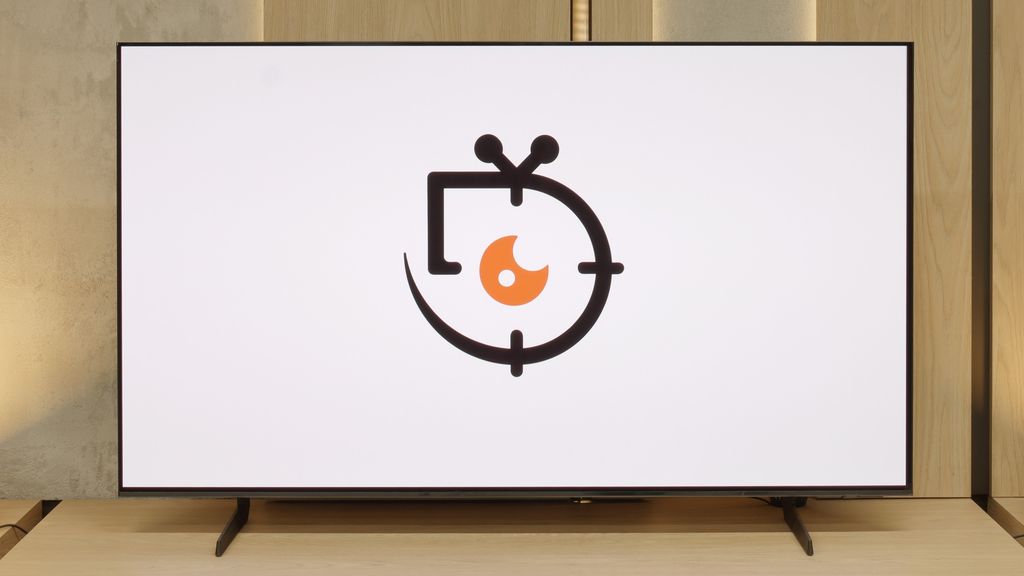

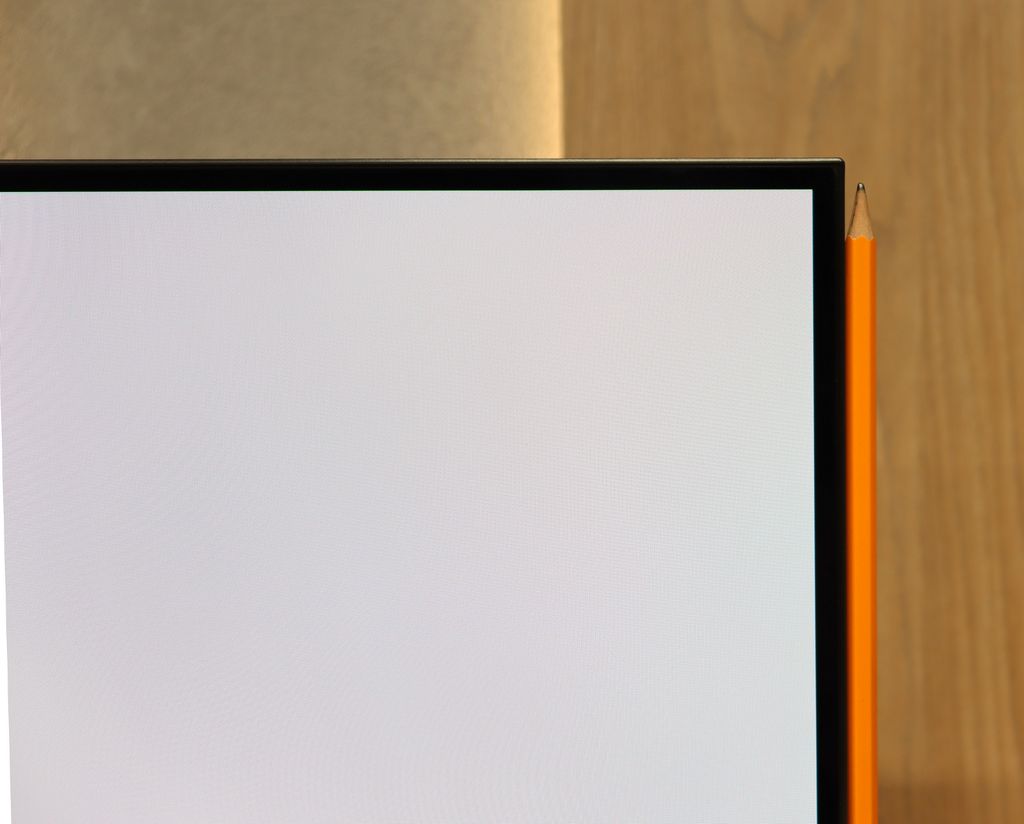
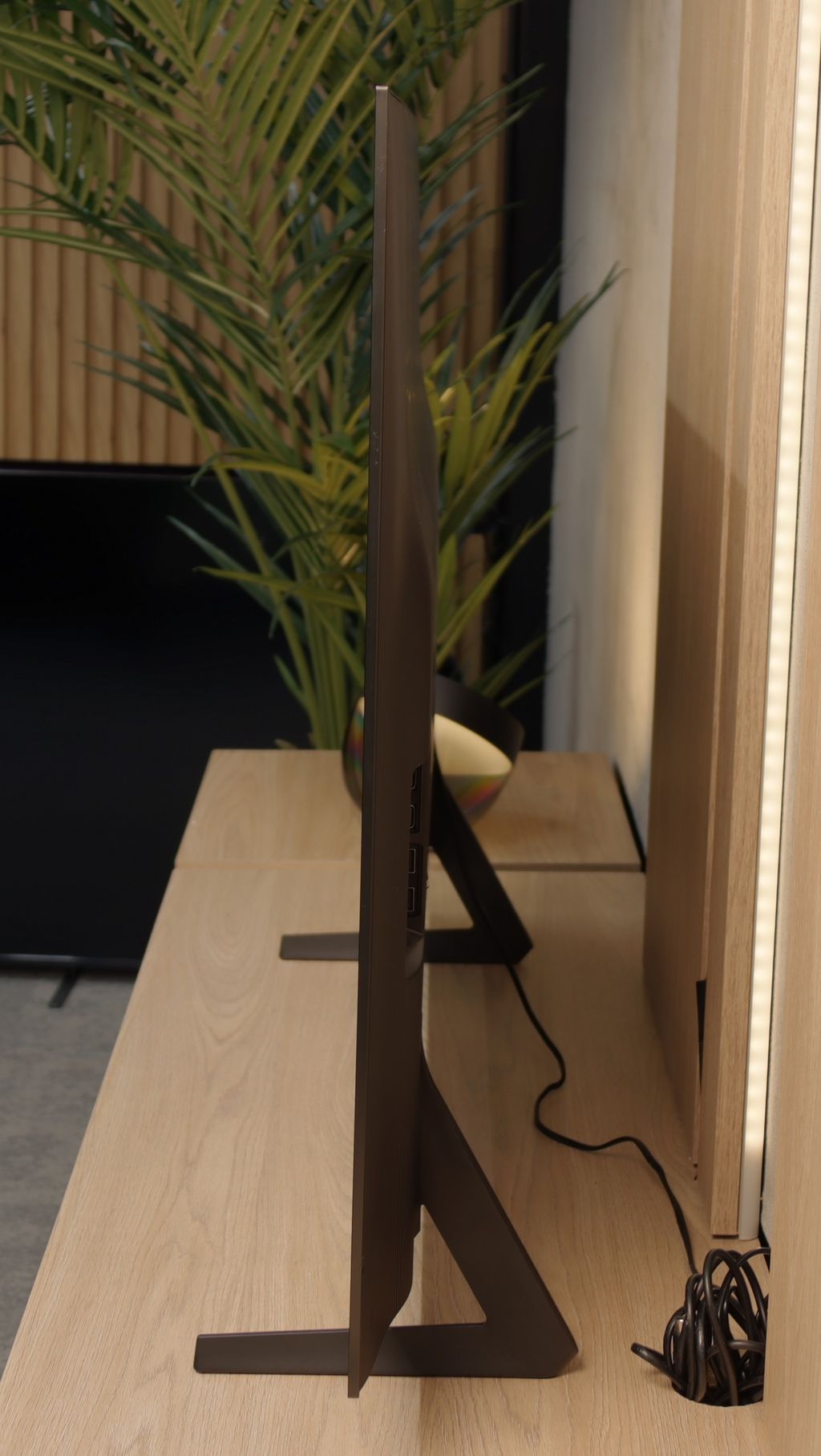
Contrast and black detail
10/10
10/10
Contrast:

Result
∞:1

Result
∞:1

Result
∞:1

Result
∞:1

Result
∞:1

Result
∞:1

Result
∞:1

Result
∞:1

Result
∞:1

Result
∞:1
Halo effect and black detail visibility:

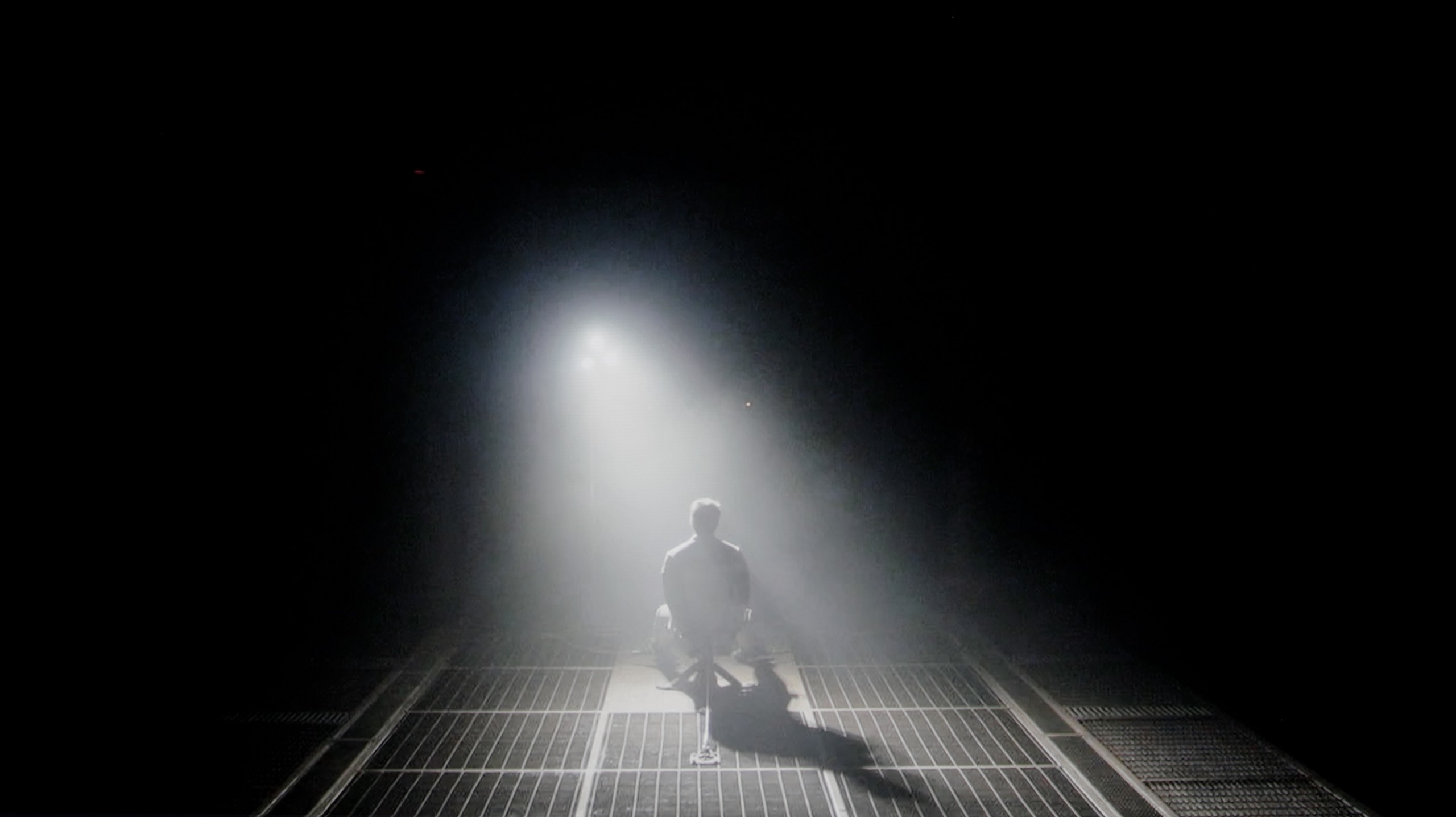
LG G4, thanks to its OLED panels produced for over 10 years, delivers perfect results in contrast, black levels, and detail reproduction in the darkest scenes. It is worth noting that the panel itself is equipped with MLA (Micro Lens Array) technology, which LG showcased just a year ago during the launch of its predecessor. The use of organic matrix allows not only for achieving pitch-black levels but also for an extraordinary immersion and three-dimensional effect of the image, which is hard to find even in the best Mini LED televisions. Such image quality is closely correlated with OLED matrix technology, as each pixel is controlled by an electric impulse rather than by blocking filters on the panel. Therefore, if we want to achieve true black, the pixel is not turned on at all. This is clearly visible in test images, where the spotlight provides high brightness while being perfectly separated from each other. The situation does not change in the demanding scene from "Sicario 2," where no imperfections are visible in the form of dimming zone issues that we may encounter in LCD televisions.
The Samsung S85F in the 55-inch version has something exceptional about it – it features a QD-OLED panel. This may sound quite surprising, but it is a fact, at least in Poland. Thus, the question arises: is the difference noticeable compared to last year's S85D with a WOLED panel? Yes, although in this particular test – black levels and contrast – it hardly matters.
Regardless of the scene, the S85F delivers infinite contrast and perfect blacks that we expect from any OLED. These are results that can impress even the most demanding cinema enthusiasts. It's worth remembering that such deep blacks can only be offered by TVs with organic panels – and it doesn't matter whether it's WOLED or QD-OLED. So, if you dream of a screen that can "turn off" the light in a scene just as effectively as an art house cinema in a dark room, the S85F is one of those TVs.
HDR effect quality
7.8/10
6.2/10
Luminance measurements in HDR:

Result
1474 nit

Result
1467 nit

Result
1403 nit

Result
1441 nit

Result
850 nit

Result
666 nit

Result
703 nit

Result
742 nit

Result
732 nit

Result
433 nit
Scene from the movie “Pan” (about 2800 nits)


Scene from the movie “Billy Lynn” (about 1100 nits)


Static HDR10


Dynamic: Dolby Vision
Dynamic: HDR10+


HDR luminance chart:
Samsung S85F OLED
Luminancja HDR
Luminance of RGB colors
LG OLED G4
Luminancja HDR
Luminance of RGB colors
LG G4 guarantees an incredibly vivid HDR effect, placing the television among the very best. The equipment of the highest model in the producer's 2024 portfolio with the second generation of micro-lens technology (MLA) has achieved a maximum brightness level of 1474 nits in real scenes. The only area where the product from the Korean manufacturer may lag behind LCD televisions with Mini LED backlighting is during the full-screen scenes featuring a lot of white. If we disregard the latter type of scene, the average result would be even higher. It is also worth mentioning scenes with very fine details, where each one shines at full intensity, which is not as evident in non-OLED televisions. The combination of such brightness and wide coverage of the DCI-P3 palette makes HDR materials more engaging than ever before.
For an OLED, the Samsung S85F can truly shine – literally. Under favourable conditions, it is capable of generating brightness exceeding 750 nits. This is hugely significant, as most films are created with displays reaching around 1000 nits in mind. In practice, this means that in scenes with moderately large, bright elements, the image can look simply fantastic. However, it's not always so rosy. When there is a huge amount of light on the screen – whether it's an expansive, bright background or a whole frame filled with white – the S85F has to tone it down. In such scenes, brightness can drop by even four times. This limitation is well-known to essentially every OLED in this price segment, so we do not consider it a particular shortcoming. However, something that deserves praise and sets this model apart from the competition is its colour gamut coverage. Thanks to the QD-OLED panel, our colourimeter recorded values exceeding 100% DCI-P3 coverage and as much as 86% for the ultra-wide BT.2020 gamut. Such results are hard to find even in televisions costing several times more.
Factory color reproduction
8.4/10
5.5/10


Factory Mode
After calibration
The best factory mode in terms of colour reproduction was "Filmmaker". This was the one we used during our tests. Let's check how its characteristics looked before the calibration process. Looking closely at the white balance first, we can notice a significant dominance of red and green. As a result, the image had a warm yellowish hue. Such characteristics are typically observed in "Cinema", "Filmmaker" or similarly named modes. The effect of this colour balance was clearly visible in both SDR and HDR content, which after switching from "Standard" mode appeared distinctly yellow. Now, let's move on to two graphs that are responsible for the brightness characteristics and consequently the contrast of the image. The first one (Gamma), representing materials with a standard colour palette, performed decently. For most of the time, midtones and bright whites were reproduced very accurately; however, it noticeably lost the darkest details, which merged into a black blob. Conversely, HDR materials, represented by the EOTF curve graph, exhibited a significant drop in contrast due to a strong boost in brightness. The colours themselves also posed a problem, as can be seen on the "ColorChecker" graph, since they were noticeably under-saturated.
Samsung, as befits a manufacturer with ambitions, has equipped the S85F with a mode called Filmmaker. Its task is simple: to ensure that the colours on the newly purchased television are as true to what the director intended as possible. Sounds great… but, as is often the case, a theory that sounds great does not always translate into perfect practice.
In the tested unit, it quickly became apparent that the image – due to an excess of blue and red – looked as though someone had overdone the saturation a bit. As a result, quite significant colour errors occurred, particularly in 4K content. Moreover, there was a problem with brightness – the S85F could brighten most scenes more than it should, taking away their intended mood.
Fortunately, Samsung televisions, including the S85F, offer an impressive number of settings for advanced calibrators. This means that we could test what this panel is truly capable of when placed in the right hands.
Color reproduction after calibration
9.5/10
9.3/10



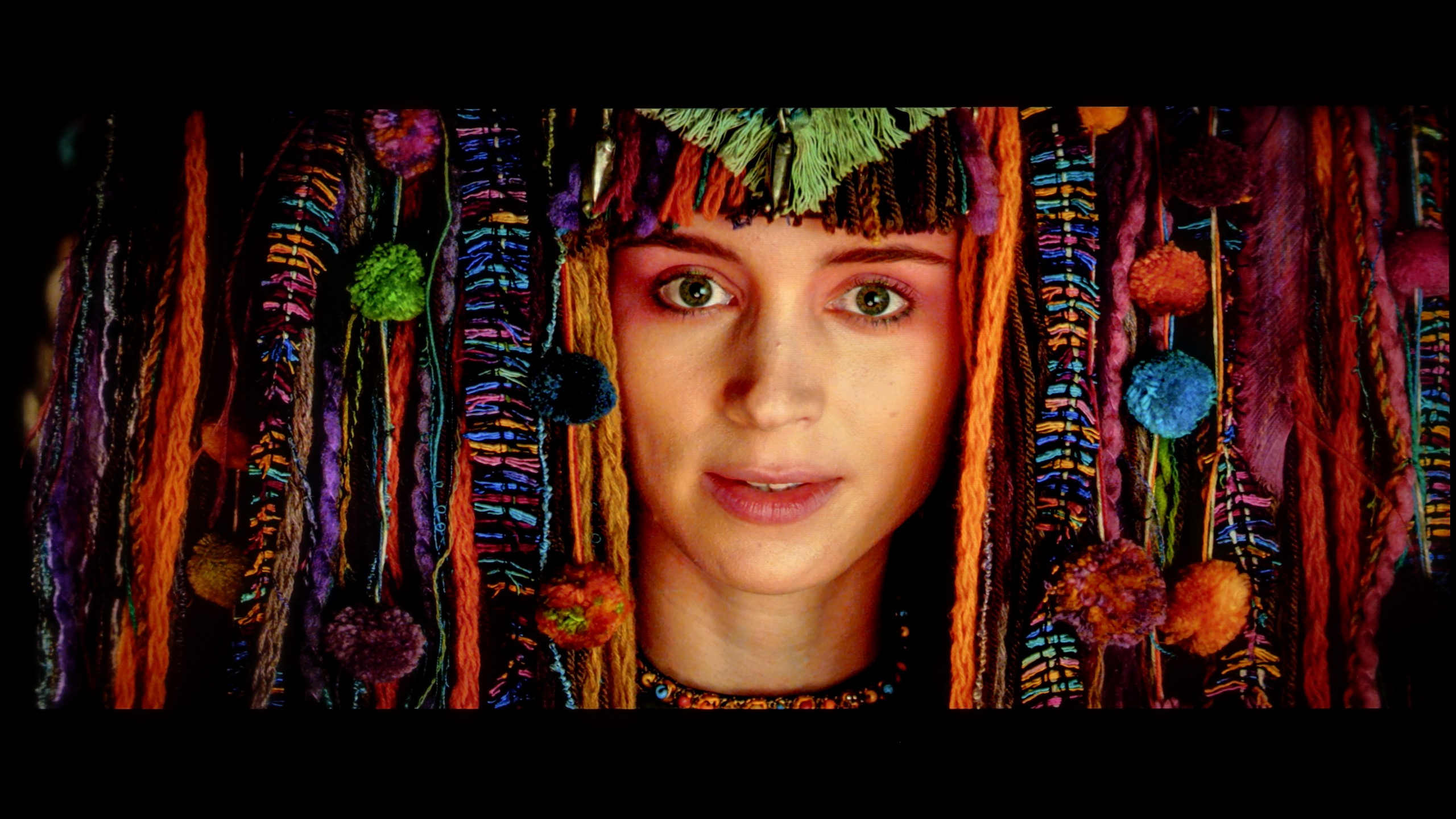
The manufacturer has implemented extensive support for the calibration process in its LG televisions for many years. We therefore used 2- and 20-point greyscale adjustments, as well as an advanced CMS (Colour Management System), and got to work. As you can see, thanks to the procedure carried out, each parameter has significantly improved. The use of tools allowed for the achievement of extremely beneficial effects, which include: studio colour reproduction, recovery of details in dark areas of the image, appropriate brightness characteristics, and suitable colour saturation. This brings us as close as possible to the reference image, which is what the film director saw on the preview monitor. It is worth noting that the LG G4 televisions alone allow for even deeper intervention in image quality thanks to the ability to calibrate with 3D LUTs. However, this is a solution recommended only for post-production or graphic studios.
Thanks to the vast number of settings in the menu, we managed to bring the S85F to nearly an ideal level. The white balance in SDR content? Literally perfect – deviations do not exceed the value of “1”. So we can confidently say that in materials with not very high dynamics, we have an image close to reference here.
In HDR content, slight issues have arisen, but they are not significant in practice – most errors fall below the threshold of perceptibility, which is the value of “3”. We also managed to tame the S85F when it comes to brightness management – the EOTF curve, even in movies, holds an almost perfect line. This is one of those cases where after calibration, you can comfortably forget about the settings and simply enjoy films and series at the highest level.
Smoothness of tonal transitions
6.2/10
7.9/10












The tonal transitions presented on LG G4 are not among the best. Each scene played from a BluRay disc with 10-bit HDR exhibited clear inconsistencies in colour transitions. This is particularly noticeable in the case of the film "The Green Knight", where issues related to posterisation were especially evident. This effect could also be observed in films of moderate and high brightness, such as "The Martian" and "Kingsman", which is rarely seen in televisions (especially of this class), which surprised us. Such results suggest that in scenes of low luminance with a large amount of black, this issue will be bothersome, even for a layperson.
Thanks to the QD-OLED panel, the colour blending on the S85F performs really very well. It is particularly worth noting how it handles the darkest, most demanding scenes – where most televisions start to struggle, this model operates almost perfectly.
Interestingly, a slight stumble can be noticed in those easier, brighter shots. There is then a minimal banding of colours, but it is so subtle that it is hard to believe it would realistically interfere with anyone's viewing experience.
Image scaling and smoothness of tonal transitions
8.2/10
7/10
Smooth transition function

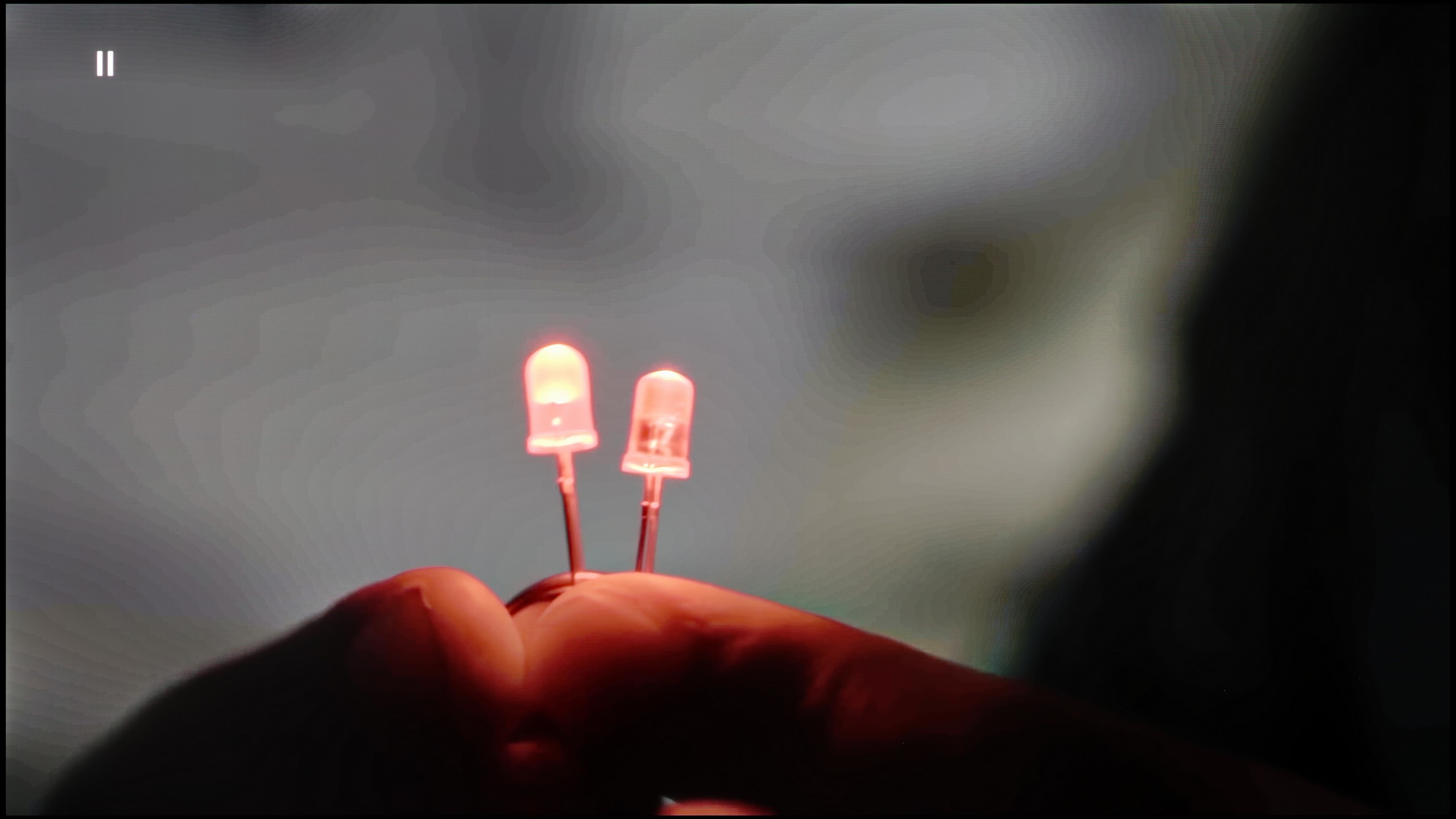
Image without overscan on the SD signal


The tested television did not perform particularly well with materials rich in tonal transitions, as a result of which we could observe a strong posterisation effect. However, there is a partial remedy for this issue. The manufacturer has equipped the LG G4 with a smoothing system called "Gentle Gradation," which we can apply at three levels: Low, Medium, and High. Each of these options guarantees quite a high effectiveness of smoothing on light colours, although it is low on darker ones. We recommend primarily using the first one, as the other two interfere with the director's intentions by removing film grain.
When watching lower-quality materials, the efficiency of the television during upscaling is extremely important. The image from the tested television is sharp and clear. However, one should pay attention to the jagged edges of fine details and minor issues around characters, such as the creation of halo effects, which occurs due to the sharpening imposed by LG G4 even when the lowest value on the slider, that is 0, is set. It is worth noting that this represents a certain change compared to the LG G3, which did not impose such strong image sharpening, even when the appropriate slider was set to position 0.
The tonal transition smoothing function in the S85F works really effectively – it can completely eliminate the problem of visible banding in very poor quality materials, such as those from YouTube. Unfortunately, even the lowest level of this option comes with compromises. Noise reduction is aggressive enough that it can smooth out the film grain that many of us consider a key element of the cinematic experience. At the "Standard" level, we did not notice that this function removed anything significant from the image, so we can recommend this setting. On the other hand, the "High" level is a different story – it can smooth out not only noise but also subtle, desirable details such as the texture of objects.
As for image scaling, the S85F performs very well. The material looks sharp, and the only minor imperfection is slightly visible aliasing of contours. And there’s still the persistent issue with Samsung televisions – overscan. This can cause the frame to be slightly cropped in certain scenes, which is worth keeping in mind when watching very old content.
Blur and motion smoothness
8.5/10
8.5/10

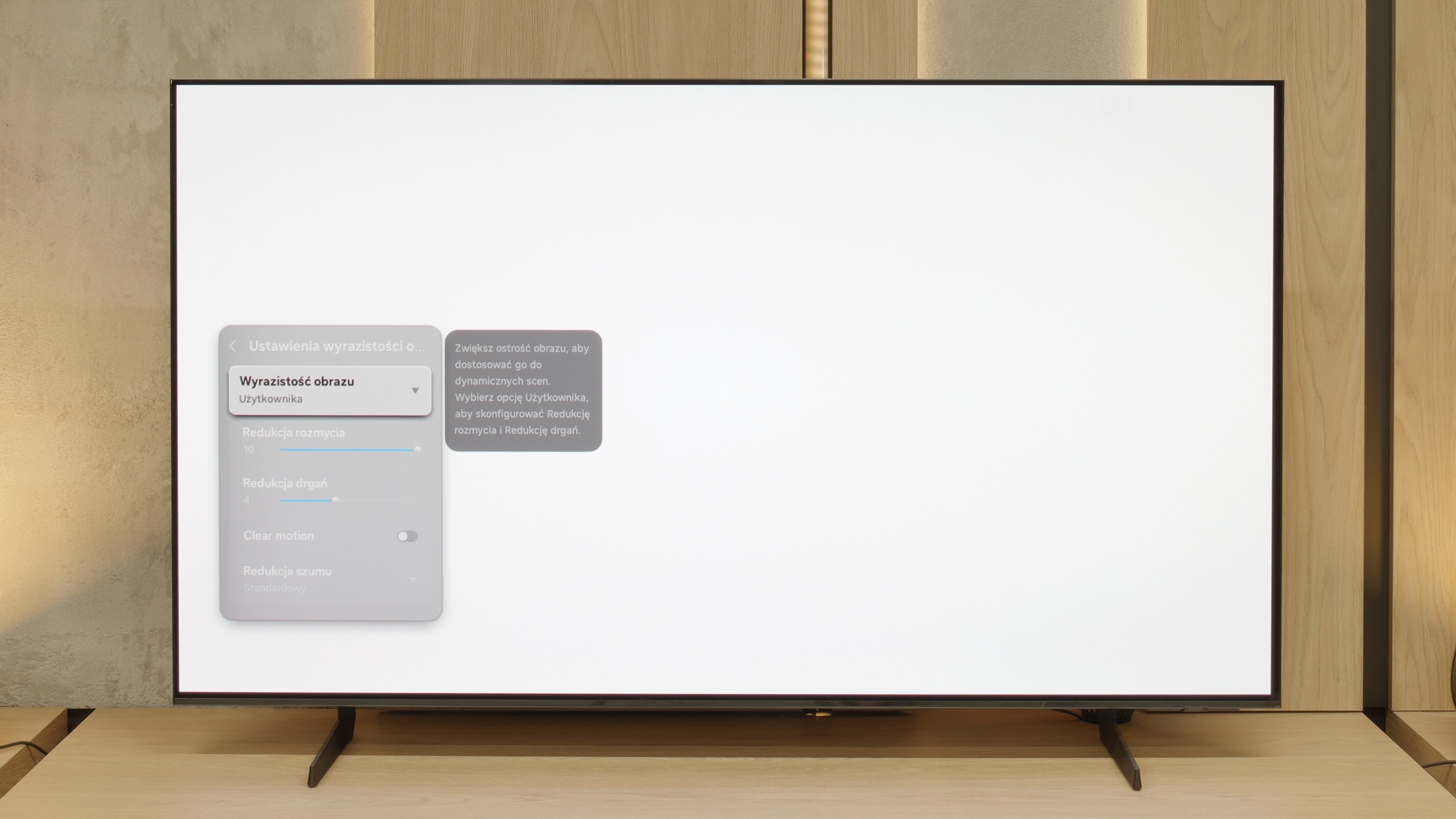
Blur (native resolution, maximum refresh rate):






Blur (BFI function enabled):
Image flickers in this mode



Image flickers in this mode



Smużenie ():
Smużenie (4K@60Hz Game Motion Plus):

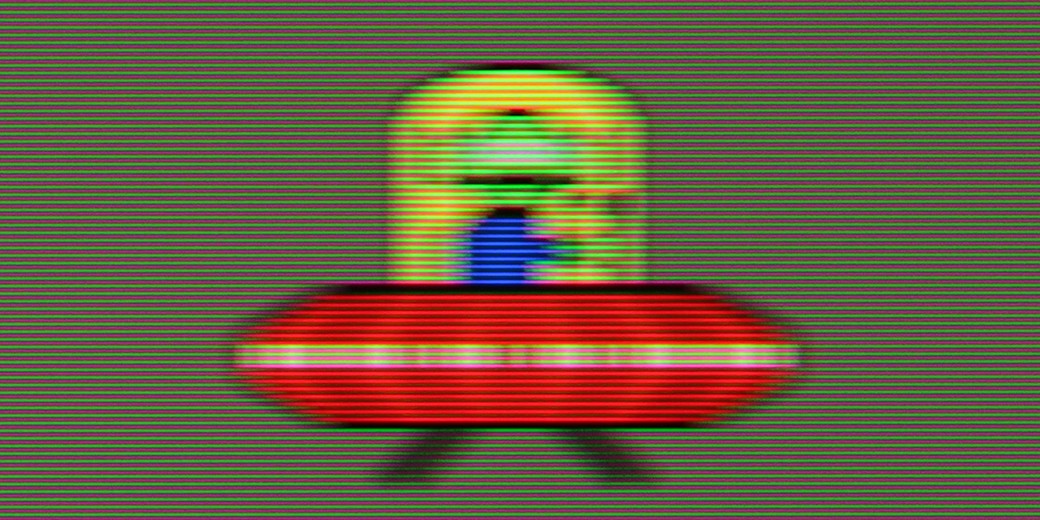
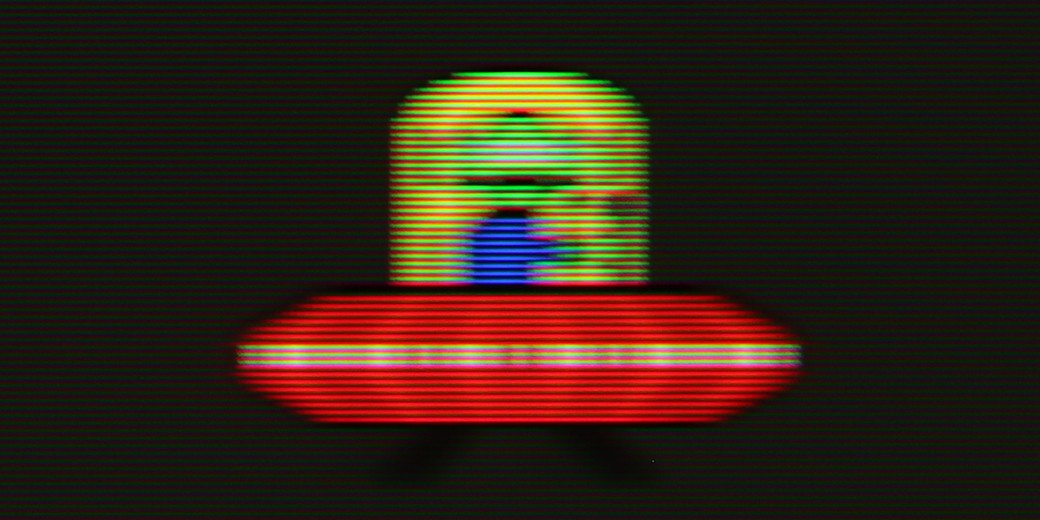
The maximum refresh rate that we can set on the LG G4 is 144 Hz. Naturally, this is only possible when the LG G4 is connected to a very powerful PC. Otherwise, we will operate at a maximum refresh rate of 120 Hz, which is recommended if we primarily want to watch sports or content with high motion dynamics. For those requiring high image fluidity, the manufacturer has implemented a multi-level motion smoother called "TrueMotion". This has been divided into two separate sliders that adjust the sharpness of moving images (De-Blur) and judder (De-Judder). Both sliders can be set in the range from 0 to 10, with each level affecting the degree of smoothness, allowing everyone to find their golden mean.
The LG OLED G4 panel features an average response time of 0.78 ms (as directly derived from our measurements), enabling an incredibly clear image, unattainable by LCD televisions, which can have response times of several milliseconds. This is perfectly illustrated by the images from the "UFO Test", which show no trailing blur behind the object. Moreover, the LG OLED G4 test revealed that the television offers the ability to precisely adjust the motion smoothing function, allowing users to select the ideal level of image interpolation. We particularly appreciated this during fast-paced actions in video games, where the LG G4 performed exceptionally well, minimising any blurring. Thanks to OLED technology, this model eliminates so-called ghosting, ensuring that the image remains sharp even in the most dynamic sporting or cinematic scenes.
The S85F is a mind-blowingly fast television – and this is not just an empty phrase for effect. Thanks to the 120 Hz OLED panel, dynamic scenes, whether in games or while watching a live match, look exactly as they should – smoothly, sharply, and without the feeling that something is “slipping away” from the frame. The lightning-fast pixel response time, typical of OLEDs, plays its part here. Transitions between frames are virtually instantaneous, and the picture remains clear even during the fastest camera movements. A ball flying across half the pitch? A car racing in a chase scene? Here, everything is clear and free from the characteristic “trail” of LCDs.
This is exactly what we expect from a good OLED – no compromises when it comes to motion fluidity. The S85F gives the impression that regardless of the pace of the action, we can focus on what is happening on the screen, rather than the imperfections of the image.
Console compatibility and gaming features
10/10
8.2/10
- ALLM
- VRR
- VRR range40 - 144Hz48 - 120Hz
- Dolby Vision Game Mode
- Correct implementation of HGIG
- 1080p@120Hz
- 1440p@120Hz
- 4K@120Hz
- Game bar

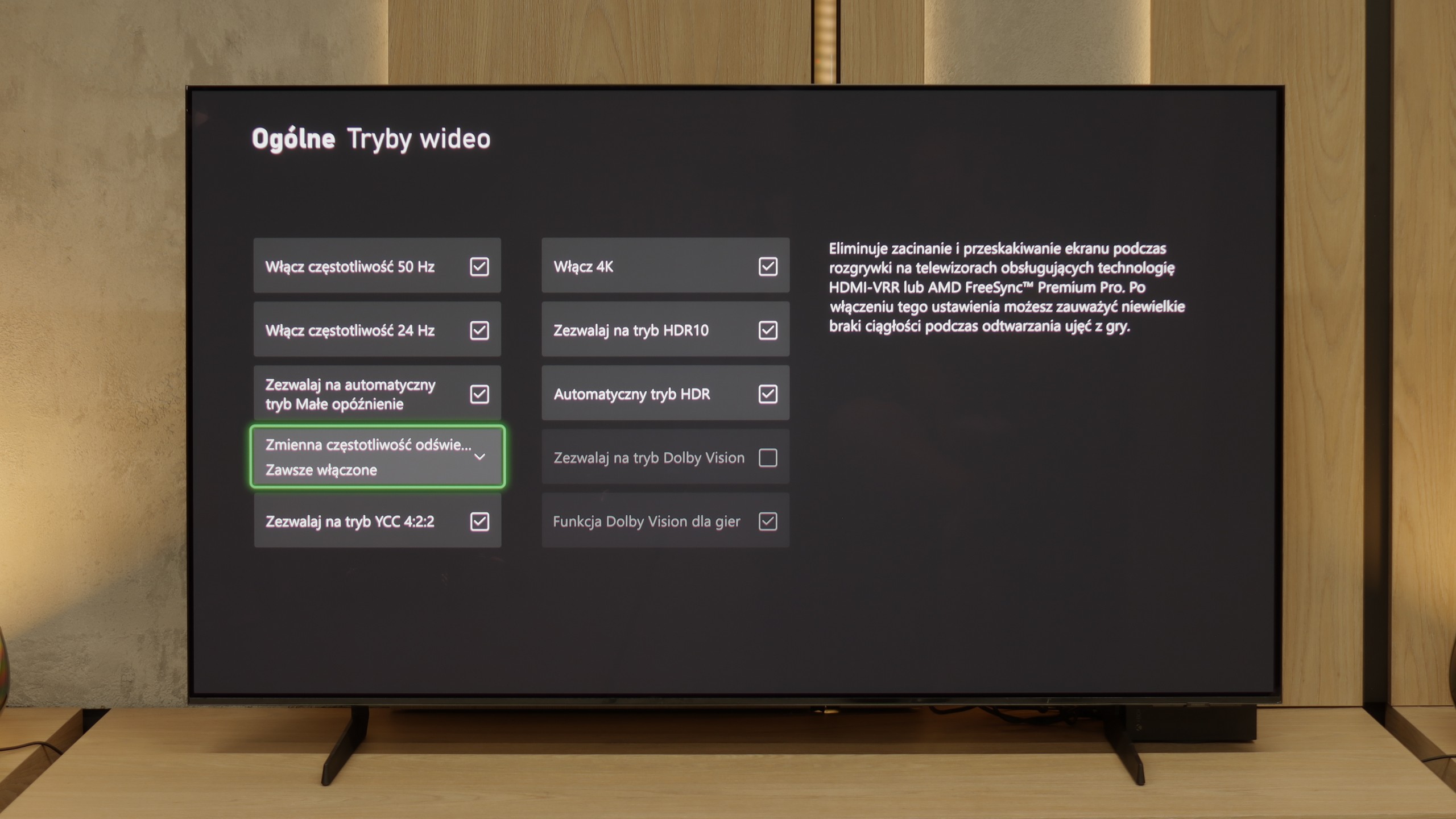

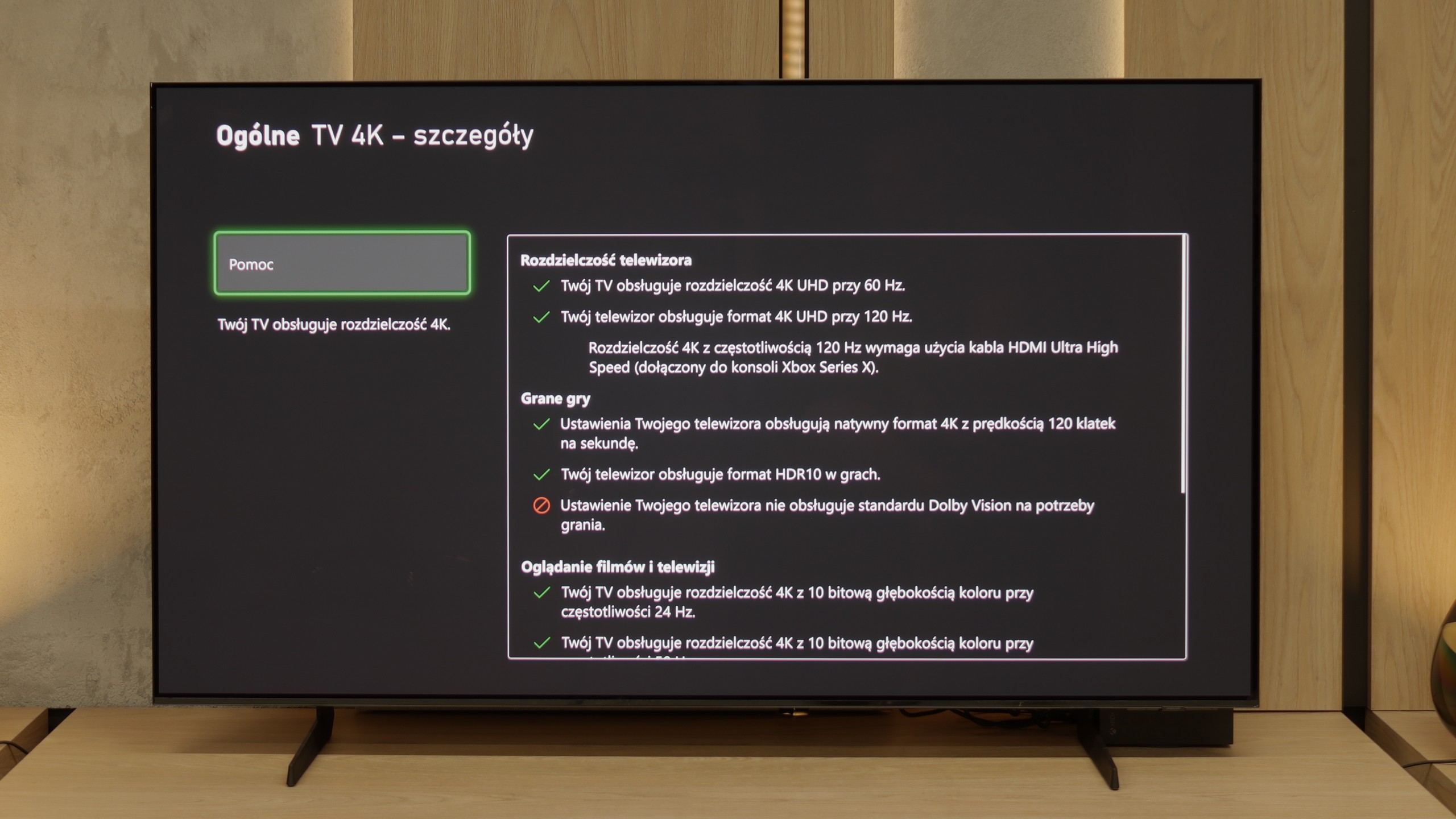

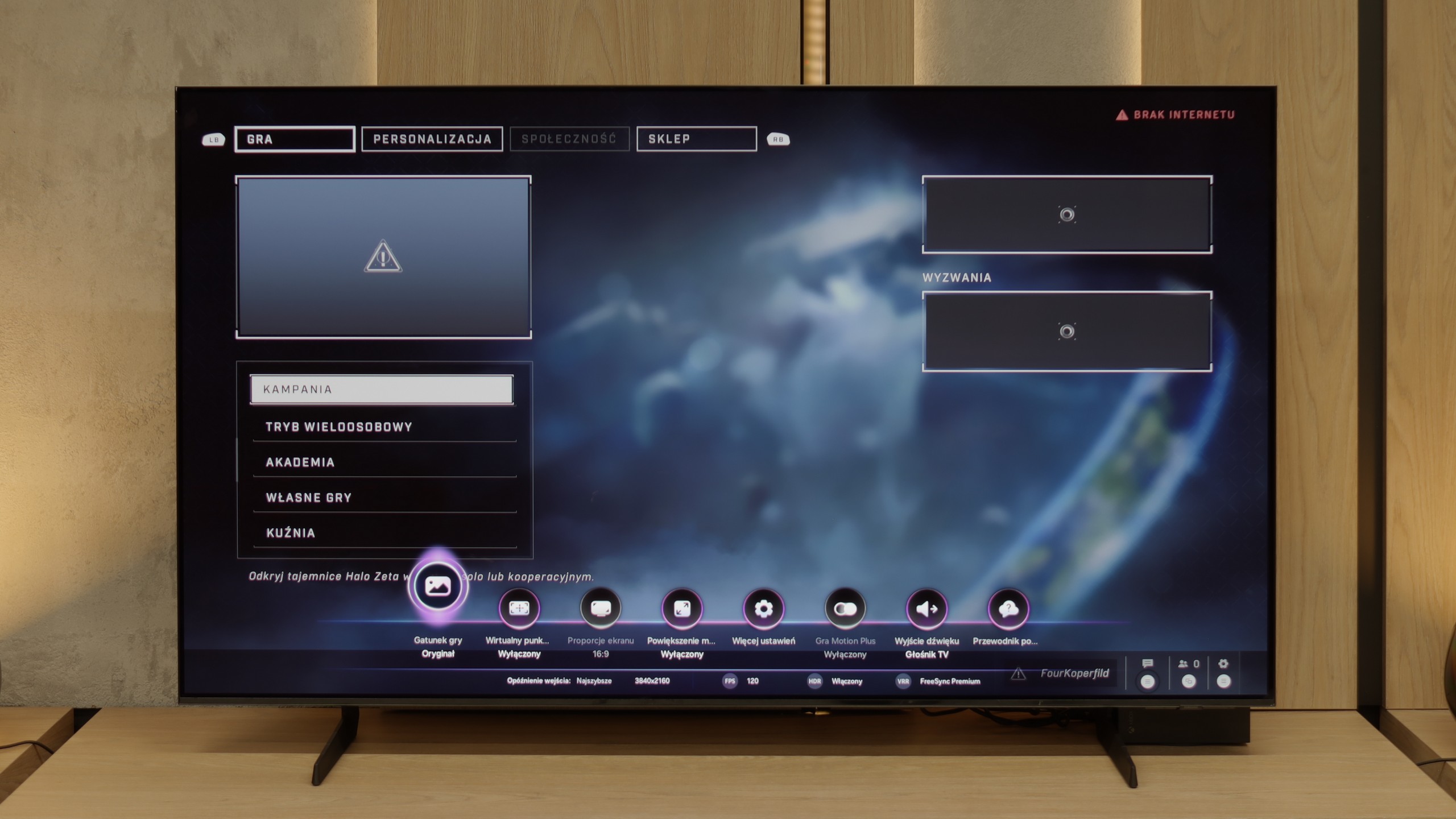

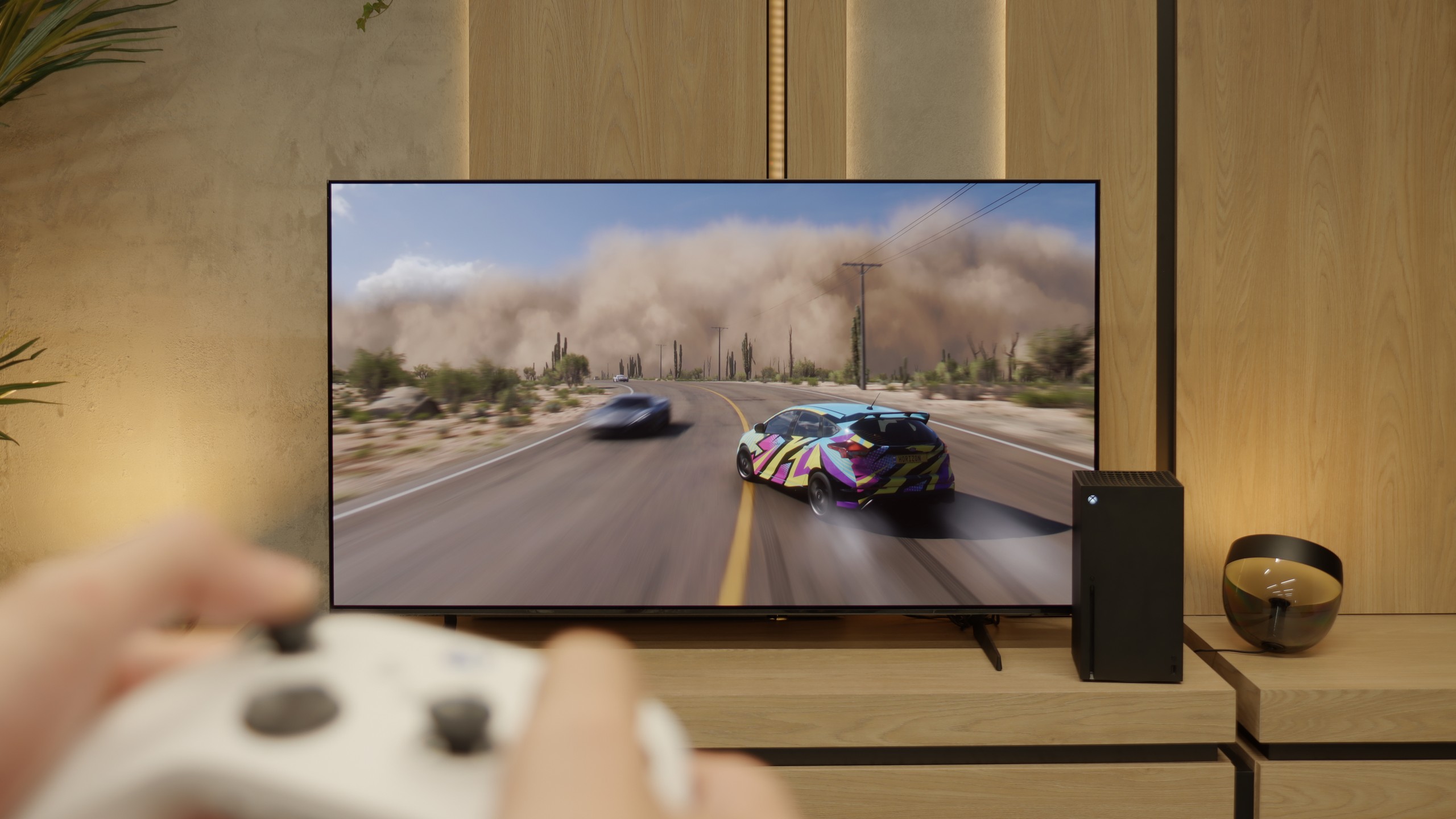
The LG G4 television supports all the features that make up the HDMI 2.1 standard. During testing, each of them activated without the slightest problem, which allows us to consider the television as designed for gaming. Their functionality will surely be appreciated by both console users and those connecting the LG G4 to a computer. It is also worth mentioning the correct implementation of the HGIG (HDR Gaming Interest Group) mode, which ensures that games mastered to brightness levels exceeding the maximum luminance of the LG G4 will correctly map tones, and the game's visuals will remain true to the original.
A nice touch is the existence of a special GameBar, which we can call up at any moment to check game parameters, but most importantly, to change them quickly. More importantly, enabling VRR technology does not degrade contrast, which is very common in televisions that feature local dimming or Mini LED backlighting. Of course, this is thanks to the OLED panel itself, characterised by pixel self-emission. As a matter of editorial obligation, we will only mention a slight grey flicker, which is somewhat normal after enabling VRR.
In summary, the LG G4, like practically all OLED televisions, is an ideal product for all kinds of games and online competitions. With fully-fledged HDMI 2.1 connections with a full bandwidth of 48 Gbit, features such as VRR, ALLM, G-Sync, FreeSync, or gaming in HDR Dolby Vision will bring much joy.
The S85F has practically everything on board to become the dream screen for gaming. Four full-fledged HDMI 2.1 ports with a bandwidth of 48 Gb/s, support for VRR, ALLM, a super-detailed Game Bar that clearly shows all parameters – and on top of that, a gem in the form of Game Motion Plus. This motion smoother makes animation in games more enjoyable, while input lag only increases slightly. This is a rare combination, and it’s a big plus for Samsung.
Now comes the moment when we need to complain a little. The lack of Dolby Vision in Samsung televisions has become standard, so there’s no point in hoping (unless something changes in a few years) – but the disappearance of HGiG after the software update is something hard to explain. HGiG (which stands for HDR Gaming Interest Group) is a mode that allows for precise reproduction of brightness in HDR games, in accordance with the creators' intentions. Without it, HDR calibration on a console becomes less precise, so we can end up with an image that is too dark in the shadows or excessively overexposed.
Perhaps Samsung will fix this in the next update – and we have high hopes for that. Because if HGiG returns, the S85F will become nearly the perfect television for gamers.
Input lag
10/10
10/10
SDR
HDR
Dolby Vision
The input lag of the LG G4 is at an incredibly low level in every scenario. Even the most passionate gamers will undoubtedly appreciate the very low input lag at demanding 4K 120 Hz settings with HDR, measuring just 5 ms. It is also worth noting that the lag at the same settings but with Dolby Vision HDR enabled remains unchanged, which is not as obvious in the competition. Therefore, it deserves the highest score and recommendation.
Here, dear players, the S85F shows its claws. 5 ms for 120 Hz content and around 10 ms for 60 Hz are results that can be described in one word in the world of televisions – phenomenal. This means that the reaction to our movements is practically instantaneous. We press the button, and the action on the screen happens without any delay, as if the television is reading our minds. In dynamic games, where a fraction of a second can decide victory or defeat, such values make a huge difference. There is no question of nervously "waiting" for the image to catch up with our movements. The S85F gives us the feeling that everything is completely under our control – and that is how it should be with equipment that aspires to be the perfect screen for gamers.
Compatibility with PC
8.6/10
7.6/10

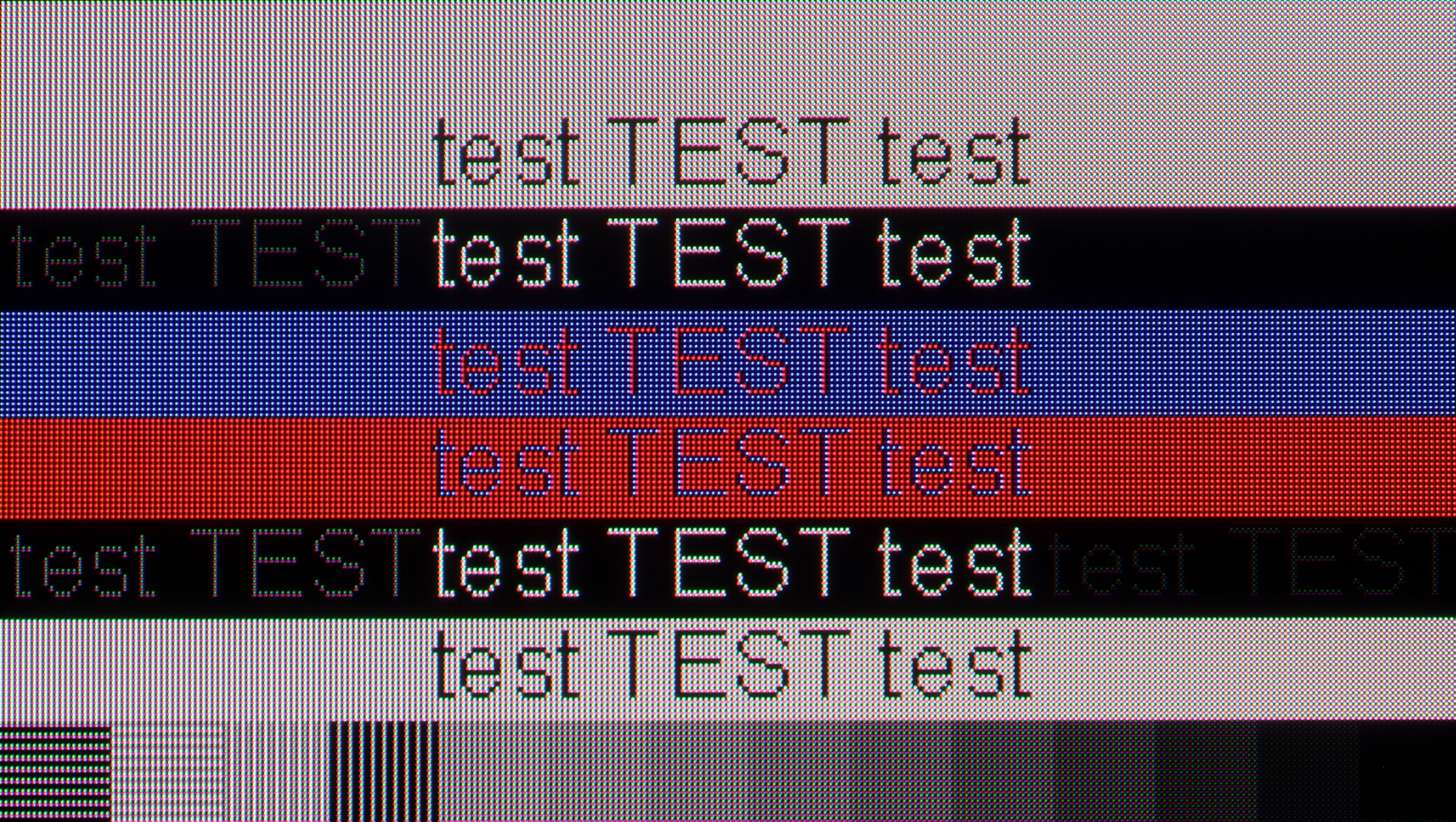
LG G4 combined with a PC performs excellently, thanks to its very low latency of just 5 ms, which is practically an instantaneous response between the mouse, the eye, and the screen. A crucial aspect when working on a screen is the readability of text, which in the case of the tested television is very good.
The RWBG pixel layout does not significantly impact the display of fonts or letters, which is a significant advantage over Samsung's QD-OLED panels. Users of both Windows and macOS equipped computers will certainly be pleased with the performance on the tested television LG G4.
If you are planning to connect the S85F to a computer, we have good news – this television is great for that. Low input lag and a 120 Hz panel make gaming on PC a pure pleasure. Whether we are talking about dynamic shooters or more tranquil RPGs, the response is instant, and the fluidity of the animations can captivate you for hours.
Of course, there's no rose without thorns. Due to the diamond arrangement of the pixels in the QD-OLED panel, there is a slight effect of "rainbow icons", particularly noticeable when sitting close to the screen. Fortunately, this is rather a detail that most of you will not find bothersome in everyday use. Especially since, thanks to the correct implementation of chroma 4:4:4, the readability of fonts is at a very good level – documents, websites, and text editors look exactly as they should.
Viewing angles
9.7/10
9.8/10
The undeniable advantage of OLED screens equipped with MLA technology is their efficiency when viewed from different angles. There are no noticeable changes to the eye, regardless of where we are viewing from. This type of screen maintains consistent brightness, saturation, and white tone, in contrast to LCD matrices or OLEDs without micro-lens array (MLA) technology. The only matrices that can rival them are those produced by Samsung Displays, using quantum dot technology, namely QD-OLED.
Here, dear readers, the S85F reaches absolute peak performance. The viewing angles are phenomenal – one of the best you can get in a television today, thanks to the unique QD-OLED panel from Samsung Display. Of course, WOLED panels can also maintain a high level in this regard, but let's not kid ourselves – what the QD-OLED in the S85F demonstrates leaves an even greater impression. The colours, contrast, and brightness remain practically unchanged even when viewing the screen from a very wide angle. This is the kind of television where you don't have to fight for the "best spot on the sofa" – everyone will see the picture in all its glory, regardless of where they sit.
TV efficiency during daytime
6/10
5.1/10

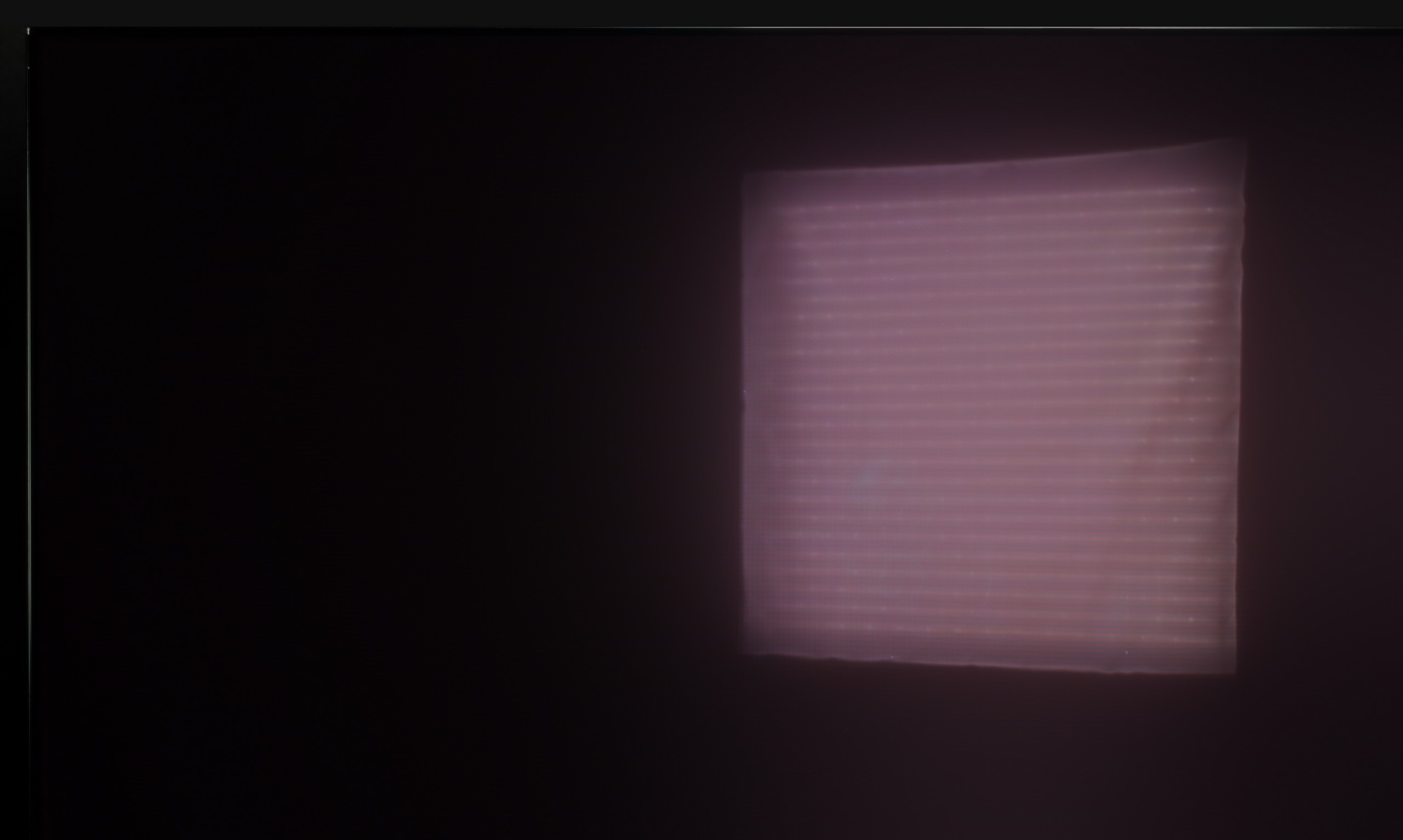


Matrix brightness
Average luminance SDR
Samsung S85F OLED: 317 cd/m2
LG OLED G4: 482 cd/m2
The glossy coating of the panel in LG G4, although it sounds like a negative, is in fact the opposite. Thanks to it, the LG G4 television maintains very high efficiency and effectively suppresses all reflections, "holding" them only at their source. It is also worth mentioning the quality of black during the day, which in the case of WRGB panels produced by LG Displays is outstanding. OLED MLA panels, despite a large number of advantages, are somewhat worse in this case, but still better in the context of competition from Samsung, whose QD-OLED panels grey out when triggered by light. The combination of brightness at around 500 nits and a glossy coating allows for daytime use of the television, unless the user has a living room with large glazing.
We really liked the saying “there's no rose without a thorn” and it fits perfectly with QD-OLED display televisions. Especially when we look at their behaviour in strongly sunlit conditions. As you may notice, in very intense light, the surface of the panel can take on a slightly cherry hue. The effect is subtle in the case of the S85F, but in extreme lighting conditions, the black can perform a little worse than in WOLED panels. However – and this “however” is key here – QD-OLED significantly better suppresses direct light reflections. This means that reflections will be less bothersome, and the picture will maintain clarity even when something bright reflects off the screen. You win some, you lose some.
As for brightness, the S85F is a moderately bright OLED. It is not a model designed for extremely sunny living rooms. If you are planning to place it in a very bright room, we recommend considering blinds or placing it in a location that at least partially protects it from direct light.
Details about the matrix
Subpixel Structure:


Panel uniformity:

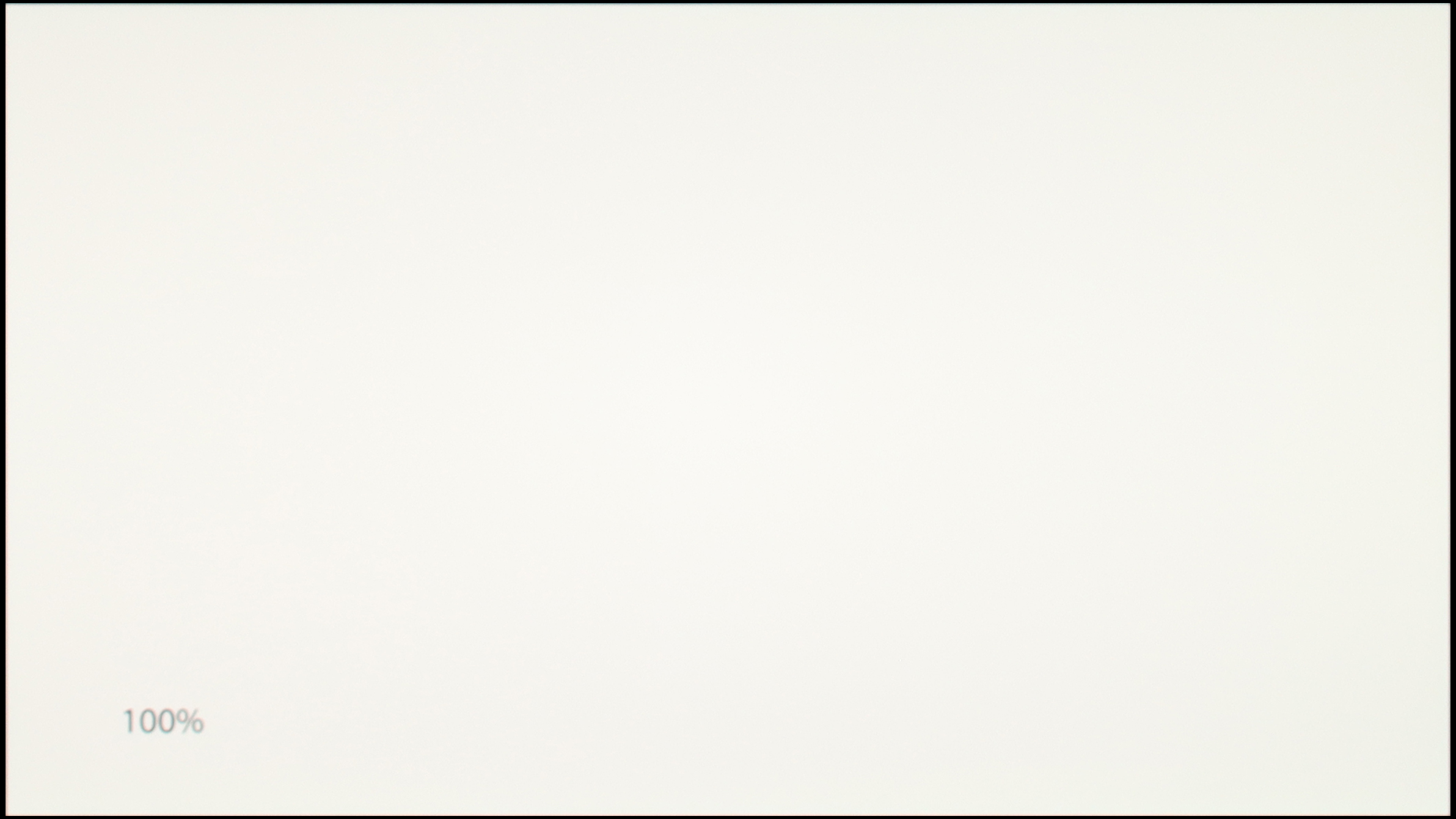
LG OLED G4
Samsung S85F OLED
TV features
9.5/10
7.2/10
- HDMI inputs0 x HDMI 2.0, 4 x HDMI 2.1 48Gbps0 x HDMI 2.0, 4 x HDMI 2.1 48Gbps
- Other inputsToslink (Optical audio)
- OutputsToslink (Optical audio), eARC (HDMI), ARC (HDMI)Toslink (Optical audio), eARC (HDMI), ARC (HDMI)
- Network InterfacesWi-Fi 2.4GHz, Wi-Fi 5GHz, Ethernet (LAN) 100MbpsWi-Fi 2.4GHz, Wi-Fi 5GHz, Ethernet (LAN) 100Mbps
- TV receptionDVB-T, DVB-T2, DVB-S, DVB-S2, DVB-CDVB-T, DVB-T2, DVB-S, DVB-S2, DVB-C
Classic features:
- Recording to USB (terrestrial TV)
- Recording programming
- Picture in Picture (PiP)
- RF remote control (no need to aim at the screen)
- Backlit remote control
- Teletext
- Audio only mode
- Possibility to connect Bluetooth headphones to the TV
- Possibility to simultaneously use Bluetooth headphones and the TV speaker
Smart features:
- AirPlay
- Screen mirroring (Windows Miracast)
- Wyszukiwanie głosowe
- Voice search in native language
- Ability to connect a keyboard and mouse


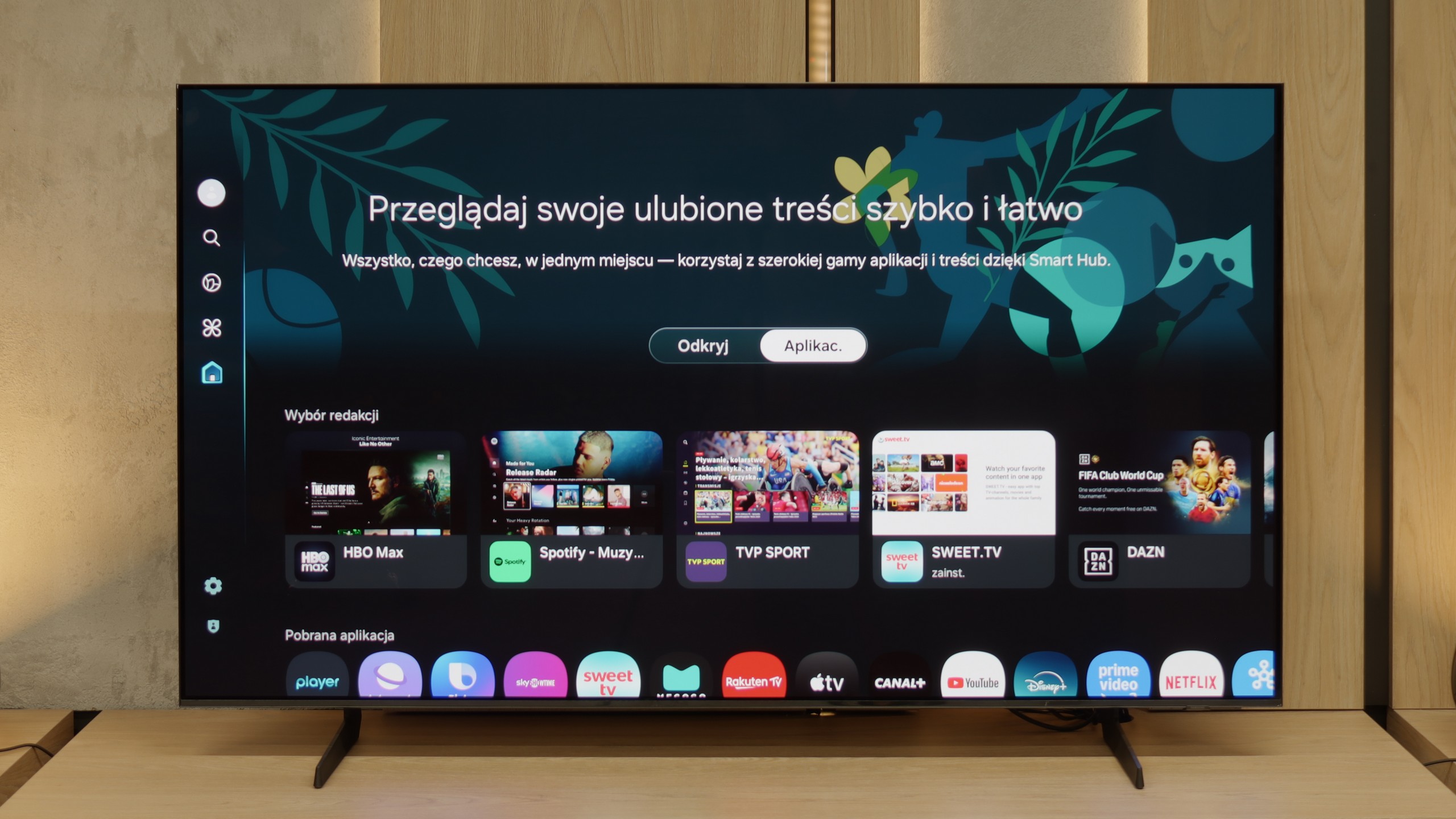
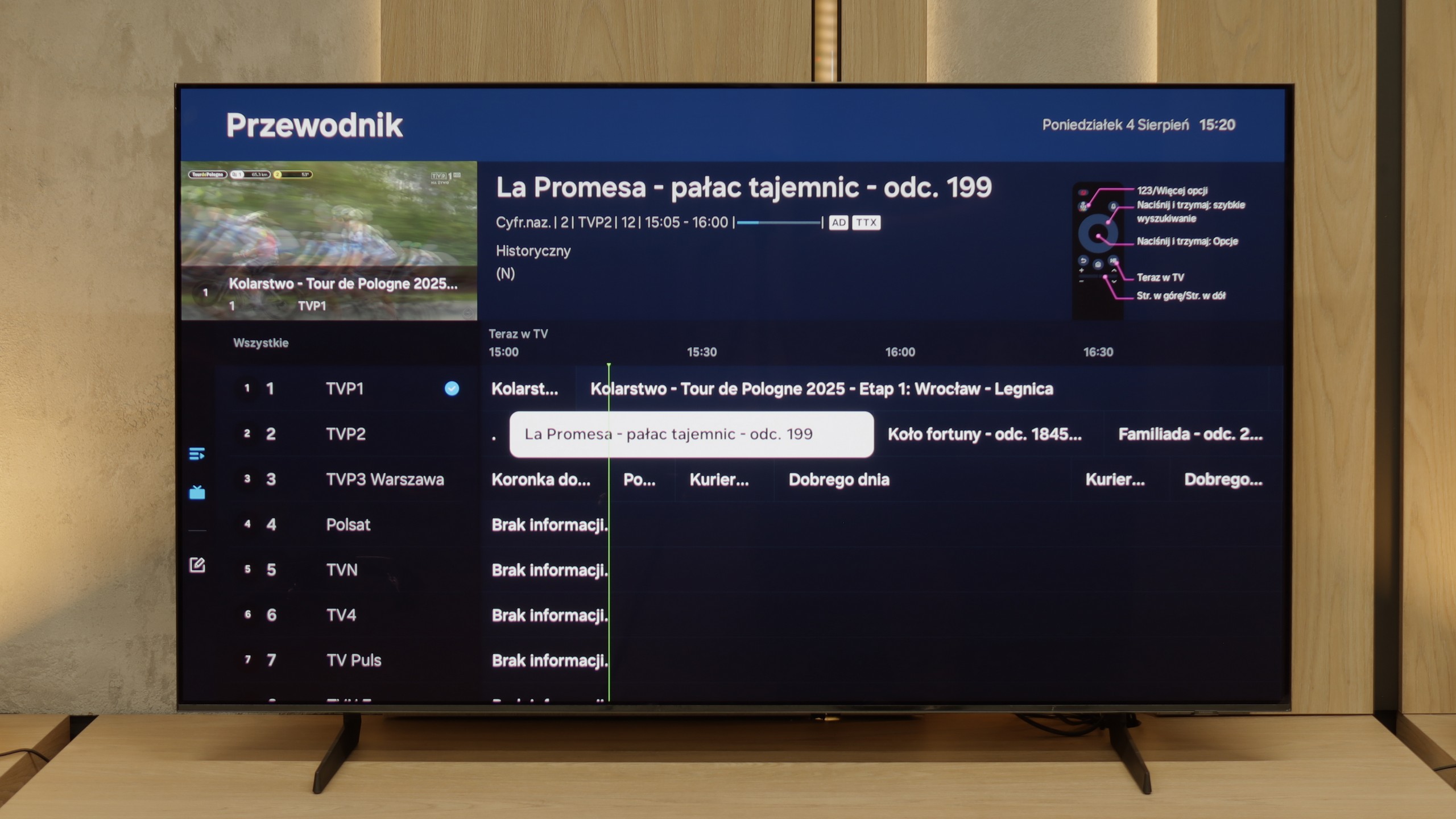
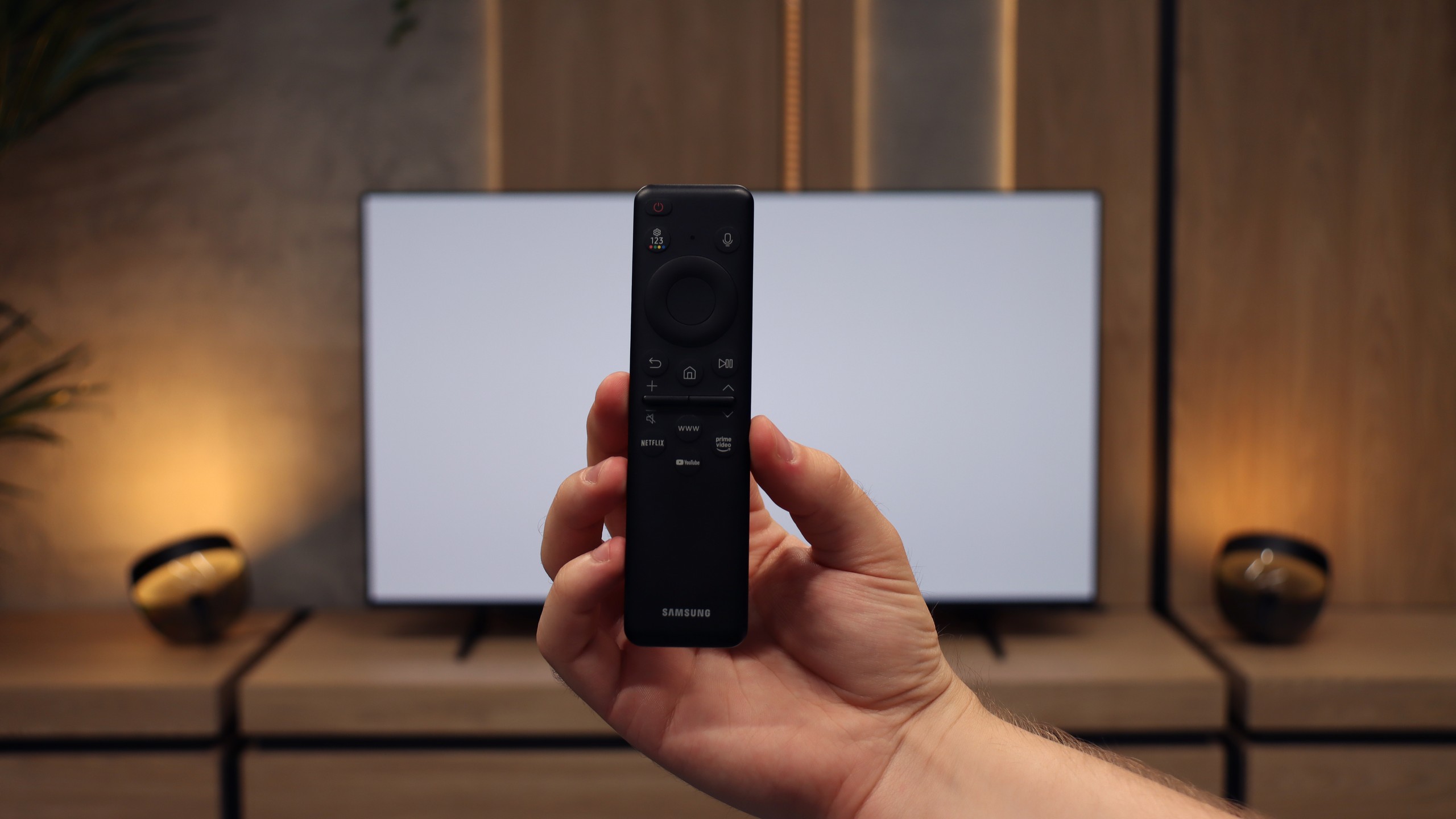

LG uses the well-known proprietary WebOS system, which has been around for many years. The system itself offers practically all the most important applications, and those that are missing can be counted on one hand, such as CDA and KODI.
WebOS also boasts a highly regarded feature that allows users to perform operations using a cursor that appears when the remote is moved. The convenience provided by this function is invaluable when typing queries or passwords for portals. WebOS, like most systems, also supports functions such as screen mirroring, AirPlay, voice search in Polish, and the ability to connect headphones via Bluetooth. On a more practical note, WebOS allows us to use both headphones and the LG G4 television speaker simultaneously, which will certainly be a great convenience for those with hearing impairments. Among the more interesting features, particularly appreciated by sports fans, is the ability to set an alert for upcoming matches, ensuring that we never miss a broadcast. The home panel also deserves praise, allowing control of all smart devices connected to the home network. For example, the end of a washing cycle will be signalled by a notification in the top right corner.
In summary, the WebOS system, although less known and having certain limitations compared to Android TV, offers stable and fast performance and supports most functions that may be needed by users. It is a solid solution for those looking for a simple and effective operating system in their television.
Classic TV Features of the S85F
The S85F was not really designed with fans of traditional television in mind. There’s no PiP feature (which is a bit surprising as Samsung usually offers it) nor the ability to record programmes to USB from the built-in tuners. Fortunately, the basics are present – teletext and a clear channel guide – so for regular, everyday viewing, that is more than enough. The included remote control, although simple and lacking a numeric keypad at first glance, allows you to control multiple devices. This means that when connecting, for example, a Canal+ decoder, you don’t need to have two remotes on the table – the one for the television is quite sufficient.
SmartTV S85F: Tizen
The smart part is a completely different story. Tizen is one of the most advanced operating systems in televisions. It operates smoothly, supports all popular internet functions – from screen mirroring, through AirPlay, to voice search. The strongest feature of Tizen is its integration with the SmartThings app, which can serve as the control centre for the entire home. Of course, like any closed system, Tizen has its limitations – for example, in the form of a smaller app library compared to GoogleTV. However, looking at the current list of available apps, it is hard to pinpoint anything that might actually be missing.
Playing files from USB
8.5/10
9.1/10
Supported photo formats:
Maximum photo resolution:

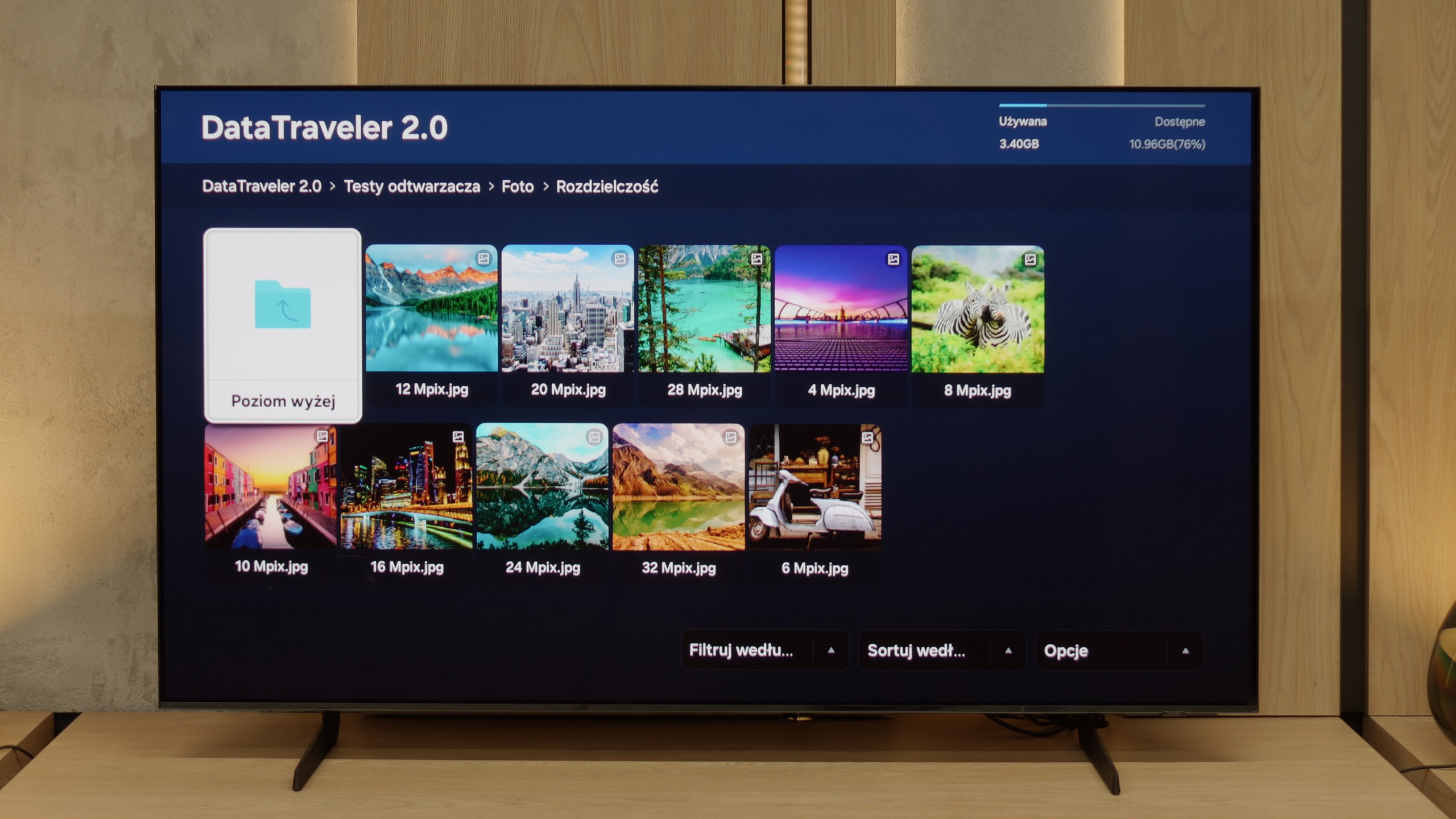
The default media player on the LG G4 performs well with most image types, although the absence of a few equally popular ones is surprising. It successfully plays videos recorded in practically all the most popular formats, including Dolby Vision. The only codec that the G4 cannot play is H.266 VVC, although this is currently rather unused. However, attention should be paid to the supported image formats, of which there are only two: JPEG and PNG. Users of Apple devices may feel disappointed by the lack of support for the HEIC format, which is the default format for photos taken. A remedy for this is to use the built-in AirPlay feature. We will also mention the lack of support for TXT subtitles.
The built-in media player in the S85F performs excellently – practically everything you put on a USB drive or hard disk will be played back without the slightest problem. Minor shortcomings appear only in the handling of some less popular photo formats, but for the vast majority of you, this will be more than sufficient. So, it can be confidently stated that for home use, the built-in player is more than solid.
Apps
8.7/10
8.7/10














































Sound
8.6/10
7.2/10
- Subjective sound quality:8.6/107.2/10
- Dolby Digital Plus 7.1:
- Dolby True HD 7.1:
- Dolby Atmos in Dolby Digital Plus (JOC):
- Dolby Atmos in Dolby True HD:
- DTS:X in DTS-HD MA:
- DTS-HD Master Audio:
The assessment of sound quality remains always subjective. However, we must give LG G4 credit for maintaining a fairly good level of sound clarity. The biggest drawback of the built-in audio system in the television is the low bass range. However, this must be viewed from a different perspective — anyone choosing this television will likely have a home cinema system. In this case, broad support for audio codecs, including DTS-HD Master Audio and Dolby Atmos, will prove crucial.
Built-in speakers with a power of 20 W on paper may not make a big impression, but in practice, the S85F can surprise. It sounds really pleasant, and at times you can even catch a subtle bass, which is not a given in this class of speakers. The TV does not support DTS format, which has unfortunately become the standard for most manufacturers by 2025. A nice surprise, however, is the support for Dolby Atmos. Of course, talking about "spatial" sound in the case of two speakers placed at the bottom of the casing would be a slight exaggeration, but it's good that Samsung offers such a feature in this model at all.


